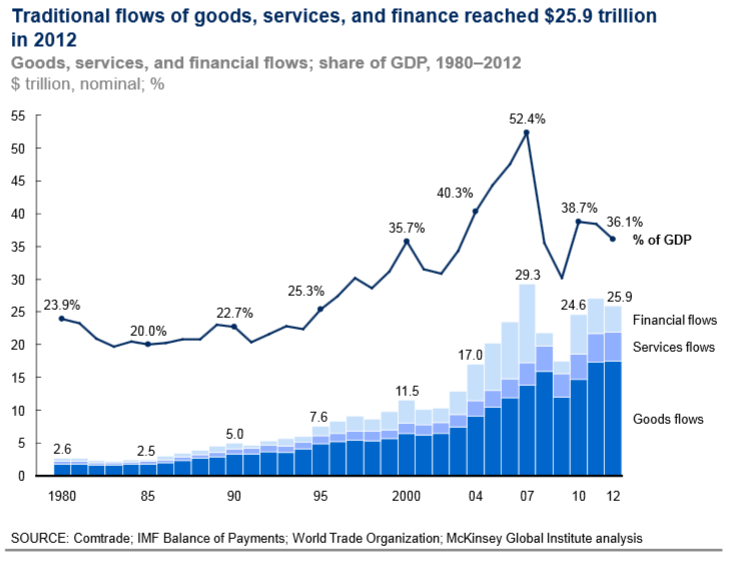Investors continue to try to wrap their heads around what China did last week with its currency. It seems like many are putting much emphasis on the move to weaken the yuan to regaining export competitiveness. We think this exaggerates the linkages between currency movement and exports.
As my colleagues Dr. Win Thin and Ilan Solot have noted, Asian exports have been weak, even for countries that have experienced currency depreciation are not reporting export growth. Most notably, Japan, which has seen the yen decline nearly 17.7% over the past year, reported a 4.4% decline in exports quarter-over quarter today as part of the Q2 GDP data. It was the biggest quarterly decline in five years.
The South Korean won has lost about one seventh of its value against the dollar over the past 12 months. In July, Korean exports were 3.3% lower than a year ago and have been consistently falling since last November (with last December the sole exception). The Taiwanese dollar has declined by about 7.5% over the past year. Its exports have fallen 11.9% over the past year. They have fallen since last December (January is the sole exception).
The Hong Kong dollar is formally tied to the US dollar. This has meant appreciation of the HKD against most currencies, yet its exports have until very recently fared better than most. Exports were firm in Q1, but fell in two of the three months in Q2, with a 3.1% fall on a year-over-year basis in June. That was the third contraction in four months. The monthly average this year has been +0.5%.
A look at the three largest eurozone members show that the 17% decline over the past 12-months has not been an unalloyed blessing. Germany's June exports were off 1.0% from a year ago. Over the past 12 months, exports have averaged a 0.7% gain. Over the past six months, 0.5% (the same as Hong Kong). Italy's exports have contracted on a year-over-year basis each month this year. In June, they were 3.6% below year ago levels. They have not been this week since 2009.
France is the exception. It exports have been robust. There has not been a negative year-over-year print since last October. The most recent reading was for June. Exports were up 8.8%, which is the strongest year-over-year performance since May 2012.
The Federal Reserve's broad trade-weighted measure of the dollar made new cyclical highs in July. US exports have fallen each month on a year-over-year basis this year. They were 3.6% lower than a year ago in June. The monthly fall this year has been 2.9%, and -0.2% over the past 12-months.
While the dollar's appreciation has been acknowledged as a headwind on US exports, something else is at work. Domestic demand in Japan, Europe and many emerging markets is weak. Moreover, what growth is taking place is generating less trade. Since the Great Financial Crisis, trade flows remains weak, as this Great Graphic from McKinsey Global Institute shows, especially relative to growth.

The World Trade Monitor reports that the volume of trade itself has been weakening. It fell in four of the first five months of the year. In May, it was up 1.2% from a year ago, which is slower than world growth. The longer-term average is closer to 7%.
The IMF's research concurs. In the 1990s, a 1% rise in global growth helped lift trade by 2.5%. Since 2013, the same increase in world GDP lifts trade by 0.7%.
China's exports were traditionally import intensive. In the mid-1990s, nearly 2/3 of the value of China's exports were derived from imported parts and materials. This may have been cut almost in half in recent years. A small depreciation of the yuan on a trade-weighted basis, paring a fraction of its earlier gains, is unlikely to boost exports.
China is not nearly as reliant on exports as many observers suggest. Net exports have been a drag of about 3% a year on average over the past decade. China transitioned from export-led growth to the investment-cum-debt growth.
Many observers would have us believe that Chinese policy makers, frustrated with the drop in the stock market and the weakening economy, have opted to move backwards to mercantilism. Instead, we suggest that last week's measures were about going forward: Going forward with the liberalization of the exchange-rate mechanism that both the IMF and the US have been advocating. Chinese officials are committed to the transition to more consumption and service-oriented growth. A slightly rich currency is conducive for this process.
One of this year's policy goals was to have the yuan be included in the next rendition of the SDR basket. We think that the move on the exchange-rate mechanism, especially if implemented as officials suggest, makes it more likely -- not less -- that the yuan will be included. The IMF's recently issued staff report recognized the hard work China has already done but calls for it to do more. It was running out of time before the IMF's formal SDR decision and, before the Fed's lift-off, which would only complicate such a move later.
